Content for TS 23.434 Word version: 19.4.2
0…
6…
8…
9…
9.3…
9.3.3…
9.3.8…
9.3.13…
9.3.20…
9.3.23…
9.4…
10…
10.3…
10.3.3…
10.3.7…
10.4…
11…
12…
13…
14…
14.3…
14.3.3
14.3.4
14.3.4A…
14.3.4A.5…
14.3.4A.8…
14.3.5…
14.3.9…
14.4…
15…
17…
18…
A…
10.3.3 Group creation
10.3.4 Group information query
10.3.5 Group membership
10.3.6 Group configuration management
...
...
10.3.3 Group creation p. 152
Figure 10.3.3-1 below illustrates the group creation operations by authorized VAL user/UE/administrator to create a group. It applies to the scenario of normal group creation by a VAL administrator or by authorized user/UE.
Pre-conditions:
- The group management client, group management server, VAL server and the VAL group members belong to the same VAL system.
- The authorized VAL user/UE/administrator is aware of the users' identities which will be combined to form the VAL group.
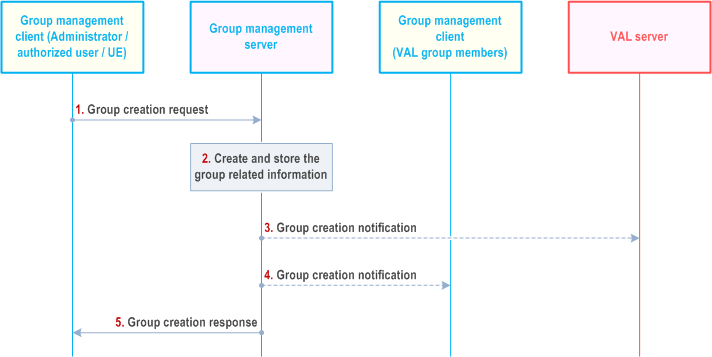
Step 1.
The group management client of the authorized VAL user/UE/administrator requests group create operation to the group management server. The identities of the users or UEs being combined and the information of the VAL services that are enabled on the group shall be included in this message.
Step 2.
During the group creation, the group management server creates and stores the information of the group. The group management server performs the check on the policies e.g. maximum limit of the total number of VAL group members for the VAL group(s). The external group identifier, identifying the member UEs of the VAL group at the 3GPP core network, is stored in the newly created VAL group's configuration information.
Step 3.
The group management server may conditionally notify the VAL server regarding the group creation with the information of the group members.
Step 4.
The VAL group members of the VAL group are notified about the newly created VAL group configuration data.
Step 5.
The group management server provides a group creation response to the group management client of the administrator/authorized VAL user/UE.
10.3.4 Group information query p. 153
10.3.4.1 General p. 153
A VAL user/UE can request the membership list on an VAL group regardless the user or UE's group membership.
10.3.4.2 Procedure p. 153
Figure 10.3.4.2-1 below illustrates the group information query on a VAL group.
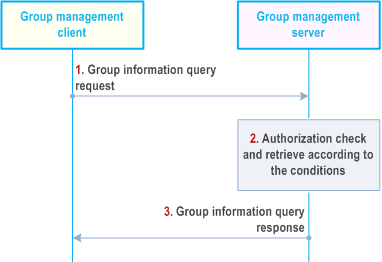
Step 1.
The group management client of the VAL user/UE requests the group information on the VAL group from the group management server by sending a group information query request. The query type is included.
Step 2.
The group management server checks whether the VAL user/UE is authorized to perform the query. If authorized, then the group management server retrieves the requested group information based on the query type.
Step 3.
The group management server sends a group information query response including the retrieved group information to the group management client.
10.3.5 Group membership p. 153
10.3.5.0 Group membership subscription p. 153
The procedure for subscription for group membership data as described in Figure 10.3.5.0-1 is used by the group management client and VAL server to indicate to the group management server that it wishes to receive updates of group membership data for groups for which it is authorized.
Pre-conditions:
- The group management server and VAL server serve the same VAL system;
- The initiator of this operation is aware of the current group membership of the VAL group;
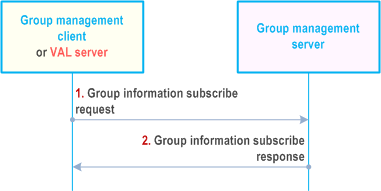
Step 1.
The group management client or VAL server subscribes to the group membership information stored at the group management server using the group information subscribe request.
Step 2.
The group management server provides a group information subscribe response to the group management client or VAL server indicating success or failure of the request.
10.3.5.1 Group membership notification p. 154
Figure 10.3.5.1-1 illustrates the group membership notification operations to the VAL server(s) and group management clients upon the group membership change at group management server.
Pre-conditions:
- VAL group is created on the group management server.
- The group management client or VAL server has subscribed to the group configuration information.
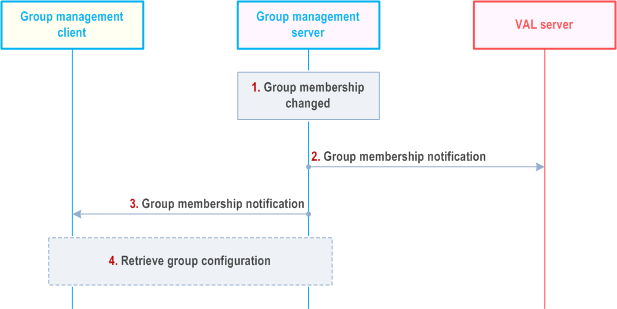
Step 1.
The membership of a specific VAL group is changed at group management server.
Step 2.
The group management server notifies the VAL server(s) regarding the group membership change with the information of the updated group members.
Step 3.
The group management server updates the group management clients of the VAL users/UEs who have been added to or removed from the group.
Step 4.
The group management client requests to retrieve the relevant group configurations from group management server, if the user or UE is added to the group. If the user or UE is deleted from the group, the locally stored group configurations in the VAL UE may be removed.
10.3.5.2 Group membership update by authorized user/UE/VAL server p. 154
Figure 10.3.5.2-1 below illustrates the group membership update operations by an authorized user/UE/administrator/VAL server to change the membership of a VAL group (e.g. to add or delete group members).
Pre-conditions:
- The group management server and VAL server serve the same VAL system;
- The initiator of this operation is aware of the current group membership of the VAL group;
-
The authorized user/
UE/ administrator/ VAL server is aware of the users' identities which will be added to or deleted from the VAL group.
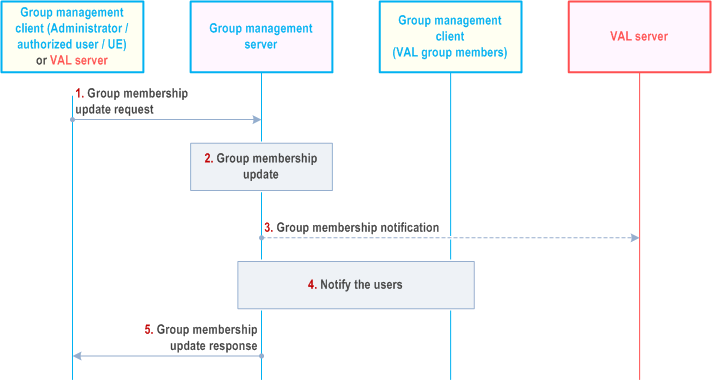
Step 1.
The group management client of the authorized user/UE/administrator or VAL server requests group membership update operation to the group management server.
Step 2.
The group management server updates the group membership information. The group management server may perform the check on policies e.g. the maximum limit of the total number of VAL group members.
Step 3.
The group management server notifies the VAL server(s) regarding the group membership change with the information of the updated group members.
Step 4.
The group members that are added to or deleted from the group by this operation are notified about the group membership change. This step may be followed by retrieving group configurations.
Step 5.
The group management server provides a group membership response to the group management client of the authorized user/UE/administrator or the VAL server.
10.3.6 Group configuration management p. 155
10.3.6.1 Store group configurations at the group management server p. 155
The procedure for store group configurations at the group management server is described in Figure 10.3.6.1-1.
Pre-conditions:
- The group management server may have some pre-configuration data which can be used for online group configuration validation;
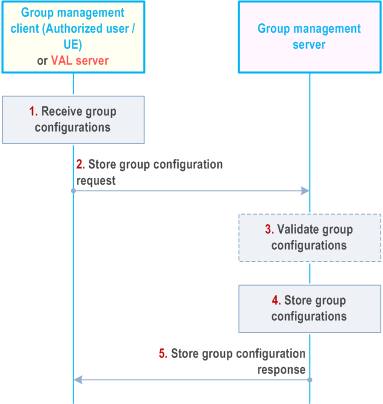
Step 1.
The group configurations are received by the group management client of an authorized user/UE or VAL server.
Step 2.
The received group configurations are sent to the group management server for storage using a store group configuration request.
Step 3.
The group management server may validate the group configurations before storage.
Step 4.
The group management server stores the group configurations.
Step 5.
The group management server provides a store group configuration response indicating success or failure. If any validation or storage fails, the group management server provides a failure indication in the store group configuration response.
10.3.6.2 Retrieve group configurations p. 156
The procedure for retrieve group configurations at the group management client or the VAL server is described in Figure 10.3.6.2-1. This procedure can be used following service authorisation when the configuration management client has received the list of groups and the group management client needs to obtain the group configurations, or following a notification from the group management server that new group configuration information is available.
Pre-conditions:
- The group management server has received configuration data for groups, and has stored this configuration data;
- The VAL UE has registered for service and the group management client or the VAL server needs to download group configuration data applicable to the user/UE.
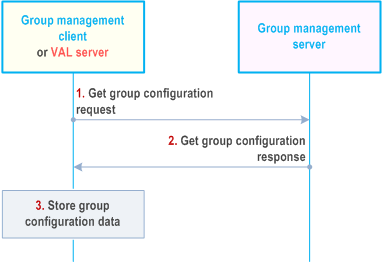
10.3.6.3 Subscription and notification for group configuration data p. 157
The procedure for subscription for group configuration data as described in Figure 10.3.6.3-1 is used by the group management client to indicate to the group management server that it wishes to receive updates of group configuration data for groups for which it is authorized.
Pre-conditions:
- The group management server has some group configurations stored.
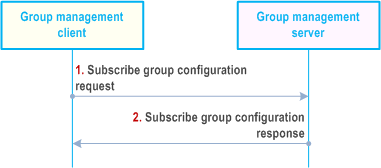
Step 1.
The procedure for notification of group configuration data as described in Figure 10.3.6.3-2 is used by the group management server to inform the group management client that new group configuration data is available. It can also be used by the group management server to provide new group related key material to the group management client.
Pre-conditions:
The group management client subscribes to the group configuration information stored at the group management server using the subscribe group configuration request.
Step 2.
The group management server provides a subscribe group configuration response to the group management client indicating success or failure of the request.
- The group management client has subscribed to the group configuration information
- The group management server has received and stored new group configuration information, or the group management server has generated and stored new key material, or both of these have occurred.
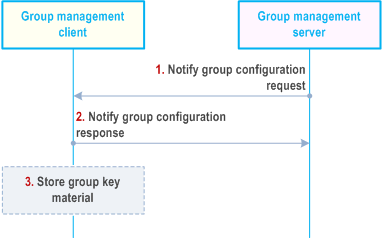
Step 1.
If the group management server has notified the group management client about new group configuration information through this procedure, the group management client may then follow the procedure described in subclause 10.3.6.2 in order to retrieve that group configuration information.
Figure 10.3.6.3-3 illustrates the high-level unsubscription for group configuration procedure used by a group management client to indicate to a group management server to stop sending notifications of group configuration data changes for groups for which it is authorized.
Pre-conditions:
The group management server provides the notification to the group management client, who previously subscribed for the group configuration information. Optionally, the notify group configuration request may contain group related key material for the group management client.
Step 2.
The group management client provides a notify group configuration response to the group management server.
Step 3.
If the group management server had provided group related key material to the group management client, the group management client stores the key material.
- The group management client has an active subscription to group configuration data changes.
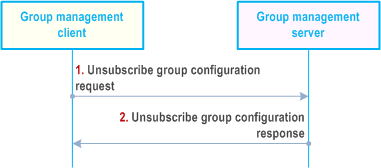
Step 1.
Figure 10.3.6.3-4 describes a procedure used by the group management client to update some parameters related to an existing subscription, for instance the notification target URI or the minimum time between consecutive notifications.
Pre-conditions:
The group management client decides to unsubscribe notifications about group configuration data changes and sends an unsubscribe group configuration request to the group management server including the information specified in Table 10.3.2.43-1.
Step 2.
The group management server shall check if the group management client is authorized to perform the unsubscribe operation. If so, the group management server cancels the subscription and provides an unsubscribe group configuration response to the group management including the information specified in Table 10.3.2.44-1.
- The group management client has an active subscription to group configuration data changes.
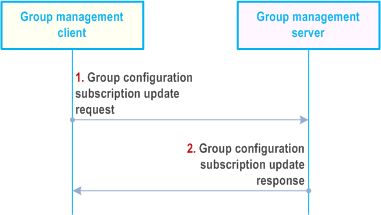
Step 1.
The group management client decides to update an active subscription and sends a group configuration subscription update request to the group management server including the information specified in Table 10.3.2.45-1.
Step 2.
The group management server shall check if the group management client is authorized to update the subscription. If so, the group management server updates the subscription and provides a group configuration subscription update response to the group management including the information specified in Table 10.3.2.46-1.
10.3.6.4 Structure of group configuration data p. 159
The group configuration data contains group configuration data common to all VAL services and group configuration data specific to each VAL service.